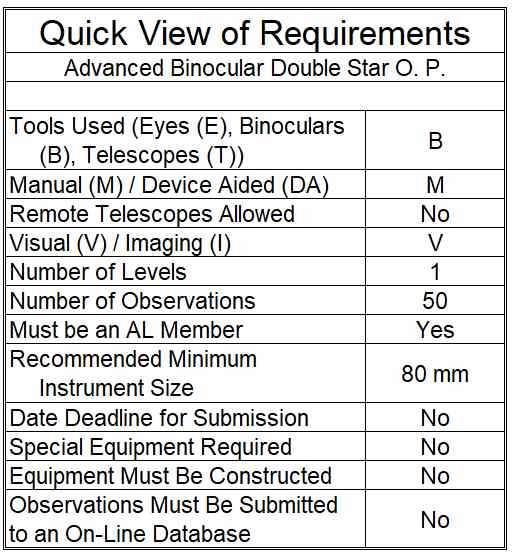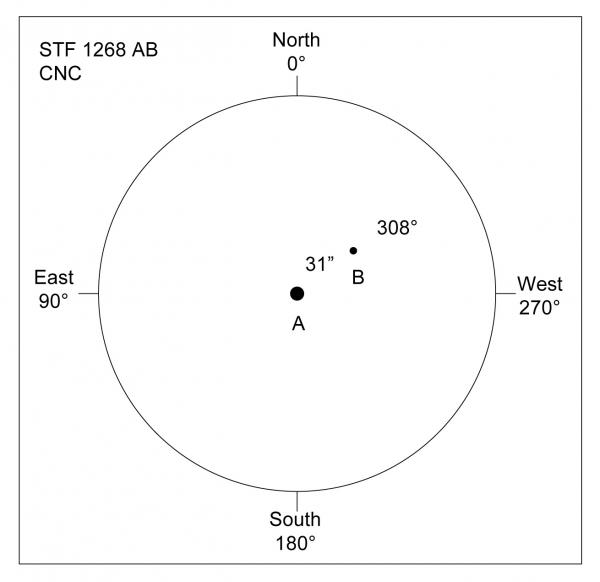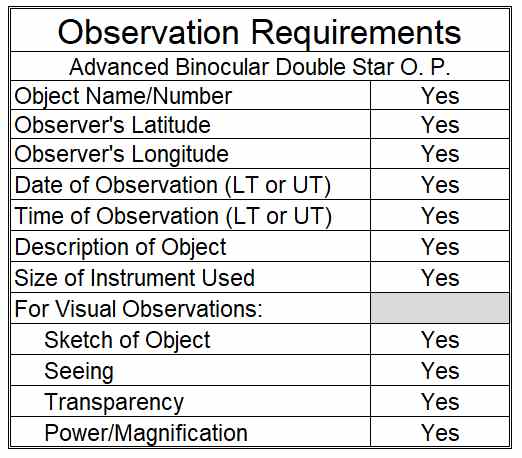Advanced Binocular Double Star Observing Program Coordinator:Bob Kerr |
  |
Introduction
Welcome to the Advanced Binocular Double Star Observing Program. Once you have completed the basic Binocular Double Star Observing Program you are eligible to earn certification in this program. The Advanced Observing Program offers you an opportunity to continue enjoying the diversity and beauty of double stars while earning your advanced certificate and pin.
As you progressed through the Binocular Double Star Observing Program, you honed your observing skills and refined techniques for locating and splitting double stars ranging from fairly easy to moderately difficult. You fine-tuned your equipment and learned how to optimize your viewing to better tackle mismatched magnitudes as well as close stellar separations. You may well have gained new insights into the “art and science” of binocular viewing and reminded yourself that observing satisfaction is not necessarily exclusive to a telescope eyepiece.
This Advanced Observing Program enables you to apply this observing expertise to a new collection of double stars featuring greater magnitude differences, tighter separations, and striking appearances. This list is found in Appendix A (Excel Version) (PDF version). Some may be observed using a 10×50 or smaller binocular, but the major portion of the Advanced Program will be most successfully viewed using mounted binoculars of 15×70 and larger. However, you may use any binocular or combination of binoculars you choose. Observers with larger binoculars are encouraged to try the more challenging pairs on the list. Binoviewers on telescopes are not allowed.

In addition, you’ll have the opportunity to demonstrate your understanding of how double stars are measured as you plot the components, positions, and separations for three objects you select from the list.
If it’s been a while since you completed the Binocular Double Star Observing Program, you may find it beneficial to review its introductory material and appendices.
Background
Organization of the Advanced Program Observing List:
The observing list consists of 100 double and multiple stars. At least 50 must be successfully observed to qualify for the Advanced Observing Program certificate and pin. When observing multiple stars, all components must be seen in order to qualify. There is no naked eye component.
Suitable for an advanced double star observing program, the objects to be observed are first located and identified by the discoverer designation codes assigned to them in the U. S. Naval Observatory’s Washington Double Star Catalog (WDS). The Catalog is the world’s principal database of astrometric double and multiple star information. It’s updated nightly, and presently contains measurements of 155,663 known visual double stars, including 36,885 binary, 7,556 optical and 111,222 of unknown relationship. The full online catalog is available here.
The object data in Appendix A is extracted from the WDS, and the coordinates provided are J2000 mean identifier coordinates from that catalog. Where Bayer letters or Flamsteed numbers are assigned, these are noted. As alternate object identifiers, the Henry Draper (HD) and Smithsonian Astrophysical Observatory (SAO) catalogs (or other) reference for the grouping’s brightest, primary star is included. The WDS designations are cross-referenced with the discoverer names in Appendix B.
You’ll note the discoverer codes are followed by numerals indicating the number of that double star in the discoverer’s own catalog. Capital letters frequently follow. These are used to identify each component star to be observed for this program. Examples are:
STF 239 – (no capital letters) this object has only two components to observe.
STF 274 AB or BU 1236 AC – both these objects have more than two components, but only two are bright enough to be observed with binoculars for this program: the primaries A and the companions B or C. The object list sets a limiting magnitude of 10.1 (the dimmest stars on the list). Depending on your vision, binocular, and sky conditions, you may see other, dimmer components. You’re encouraged to make a note of this on your log. The brightest star is mag. 3.
STF 2993 ABC – each letter represents a star to be observed. This object has three components.
STF 630 A-BC – hyphenated objects are comprised of at least three components, but in this example the B and C stars are so close their light is blended and they appear as a single point. It will appear you’re seeing two stars in these objects.
Also new to the Advanced Observing Program is a column denoting the differences in magnitudes between the primary and companion stars, commonly designated by the symbol ∆m. As you are aware, the greater the magnitude difference, the more challenging it will be to split the pair, particularly where separations are close. Dark skies with steady seeing will be of great benefit for this Observing Program.
Compiling the Advanced List:
A group of experienced binocular double star observers assisted me in viewing and qualifying stars for this list. To these talented amateur astronomers I extend my deepest appreciation. The most commonly used optics to check the effects of magnification and aperture on these doubles were 10×50, 15×70, and 20×80 binoculars, the latter providing the most satisfactory results.
In the end, I sorted through an extensive roster of double stars to arrive at this unique collection of exciting binocular double stars. I hope you enjoy tracking them down and observing them.
Those wanting to know more about how the relationship of magnification and aperture affect binocular performance might wish to read an in-depth report by Ed Zarenski on Cloudy Nights, http://www.cloudynights.com/documents/performance.pdf.
Appendix A (Excel version) (PDF version)
Double Star Measurements and Resources:
The observation and measurement of double stars by amateurs has a long tradition that continues to this day. It remains an area where non-professionals can conduct real science and contribute to an important, on-going field of research.
Over time, repeated measurements of double star separations and position angles are made. Each separation and position angle measurement, essentially a snapshot, progressively traces out the orbits of binary stars and leads to the calculation of absolute stellar masses. Many small to mid-sized backyard telescopes, when properly equipped, are suitable for this fascinating work (no light buckets required). These updated measurements by amateurs and professionals alike are regularly added to the Washington Double Star Catalog. For more information on organizations devoted to double star research see http://www.webbdeepsky.com/notes/doublest01.html and http://www.jdso.org/. The second edition of Observing and Measuring Visual Double Stars by Bob Argyle (Springer, 2012) provides a wealth of information on this subject, including CCD astrometry.
The Advanced Observing Program Measurement Plots:
To demonstrate the basics of double star measurements, you’ll create plots using three objects from the observing list. Using the magnitude, separation, and position angle measurements from the WDS database provided, translate what you observe in the night sky onto paper. Plot the relationships of the stars in three objects you select from the list. (See the example below for the required format.) All the information you need for these layouts is provided in the WDS measurements that accompany each object. Two of the plots must be of objects you’ve personally observed. The third drawing must be of a multiple (three or more stars) from the list, whether or not you have observed it.
An example of a plot for STF 1268 AB in Cancer:
| Cons. | WDS | Other | RA | Dec. | Magnitudes | ∆m | Sep (“) | PA (°) |
| CNC | STF 1268 AB | ι | 08 46 7 | + 28 46 | 4.1, 6.0 | 1.9 | 31 | 308 |

Your plots will place the primary star and each component star in its proper position relative to each other and relative to its position in the sky. Label each plot using the appropriate discoverer code, and identify each star using its capital letter identifier. Use dots of varying sizes to show differences in magnitude. Separations (distances) between stars are labeled in seconds of arc (“). Position angles are labeled in degrees with 0° (North) at the top and progressing West in a counterclockwise manner.
These are simple drawings requiring little artistic talent; however, legibility and accuracy are required. Reviewing the material in the fifth paragraph of Appendix A of the basic observing program may be helpful.
Definition of Binoculars Allowed for Observations
The Astronomical League defines a binocular telescope as an observing device with two optical tubes and two eyepieces, where the eyepieces can be replaced with eyepieces of different focal lengths. “Bino-Viewers” have a single optical tube, but two eyepieces. “Bino-Viewers” and Binocular Telescopes may be used in any Observing Programs that are telescope based. They may not be used in binocular programs.
Observing devices with two optical tubes and two eyepieces, where you cannot change the eyepieces, are binoculars. Binoculars may be used in any Observing Program requiring telescopes or binoculars. Most binoculars do not have sufficient magnification to replace telescopes.
Requirements and Rules
This certification is available to members of the Astronomical League, either through their local astronomical society or as members at large. If you are not a member and would like to become one, check with your local astronomical society, search for a local society on the Astronomical League Website, or join as a member at large .
Log your 50 Advanced Observing Program observations and include the information listed below in the form of your choosing, as long as it contains the required content. Your description of what you see needs be no more than a sentence or two stating your impression of the double stars and other prominent celestial features viewed within your binocular field. It is perfectly acceptable if you prefer to sketch and label this view instead. Sketching does not replace the requirement for plotting. We appreciate your efforts to submit a log that is clear and legible.
| Your submission must include your Binocular Double Star Observing Program certification number, which will be found on your Award Certificate.
Your Advanced Observing Program observation log must include for each object:
|
 |
Submission for Certification
| To qualify for the Advanced Binocular Double Star Observing Program certificate and pin, observe at least 50 double or multiple stars from the observing list following the reporting requirements as stated above, and include your three plots.
When completed, send your submission along with your name, address, phone number, e-mail address, and society affiliation directly to the Observing Program Coordinator. |
 |
We hope working on this Advanced Observing Program brings you many pleasant hours under the night sky with your binoculars.
What’s better than settling into your observing chair – charts, lists, and red flashlight close by – with stars overhead and your instrument at your fingertips? Where will you go tonight?
Clear Skies and have fun!
Bob Kerr
Upon verification of your submission and of your active membership in the Astronomical League, your recognition (certificate, pin, etc.) will be sent to you or to the awards coordinator for your society, as you specified. Your name will also appear in an upcoming issue of the Reflector magazine and in the Astronomical League’s on-line database. Congratulations. Good luck with your next observing challenge.
Advanced Binocular Double Star Observing Program Coordinator:
Links:
- Find Your Observing Program Award
- Appendix A – Advanced Binocular Double Star List (Excel format) (PDF format)
- Appendix B – Advanced Binocular WDS Codes
- Award Pin



